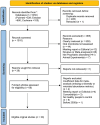Altered oral microbiome composition in mental disorders: a systematic review and meta-analysis
- PMID: 40761437
- PMCID: PMC12320252
- DOI: 10.1080/20002297.2025.2541828
Altered oral microbiome composition in mental disorders: a systematic review and meta-analysis
Abstract
Introduction: Emerging research underscores the gut-brain axis in mental disorder pathophysiology, yet the oral microbiome's contribution to mental health remains underexplored. Elucidating oral microbial signatures in mental and neurological disorders may reveal novel pathobiological mechanisms and advance biomarker discovery for precision diagnostics and microbiota-targeted interventions.
Methods: This systematic review and meta-analysis investigates oral microbiota alterations across 6 different mental disorders, by synthesizing data from 20 case-control studies retrieved from PubMed, Embase, and Cochrane Library. Relative microbial abundance and beta diversity indices were extracted from between-group comparisons. Random-effects meta-analyses were conducted for alpha diversity to characterize microbiota differences between patients and controls.
Results: Key findings included a significantly higher Simpson Index in patients (SMD = 0.42; 95% CI, 0.25 to 0.60) compared to controls. Beta diversity varied significantly only in SZ and MDD. Condition-specific variations in microbial abundance were observed: Rothia enrichment in ASD, overrepresentation of H2S-producing genera in SZ, and reduced Solobacterium and Leptotrichia in MDD.
Conclusion: Collectively, the meta-analytical synthesis suggests alterations in oral microbiota diversity across mental disorders. Disease-associated microbial shifts highlight the oral microbiome as a candidate factor warranting further investigation for potential diagnostic applications and microbial-targeted therapeutic strategies.
Keywords: Oral microbiota; alpha diversity; autism spectrum disorder; mental disorders; microbiome dysregulation; salivary biomarkers.
© 2025 The Author(s). Published by Informa UK Limited, trading as Taylor & Francis Group.
Conflict of interest statement
No potential conflict of interest was reported by the author(s).
Figures





Similar articles
-
Systematic analyses uncover robust salivary microbial signatures and host-microbiome perturbations in oral squamous cell carcinoma.mSystems. 2025 Feb 18;10(2):e0124724. doi: 10.1128/msystems.01247-24. Epub 2025 Jan 28. mSystems. 2025. PMID: 39873508 Free PMC article.
-
Intratumoral microbiota composition in women's cancers: a systematic review and meta-analysis.Front Oncol. 2025 Jun 12;15:1544786. doi: 10.3389/fonc.2025.1544786. eCollection 2025. Front Oncol. 2025. PMID: 40575164 Free PMC article.
-
Association Between Oral Dysbiosis and Depression: A Systematic Review.J Clin Med. 2025 Jul 21;14(14):5162. doi: 10.3390/jcm14145162. J Clin Med. 2025. PMID: 40725857 Free PMC article. Review.
-
The oro- and nasopharyngeal microbiota as a revolutionary perspective on mental disorders and related psychopathology: a systematic review and meta-analysis.J Transl Med. 2025 Jul 2;23(1):726. doi: 10.1186/s12967-025-06759-x. J Transl Med. 2025. PMID: 40604974 Free PMC article. Review.
-
Effects of prebiotics and phytochemicals on serum trimethylamine N-oxide reduction and gut microbiota: a systematic review and meta-analysis.J Transl Med. 2025 Jul 9;23(1):759. doi: 10.1186/s12967-025-06806-7. J Transl Med. 2025. PMID: 40634923 Free PMC article.
References
Publication types
LinkOut - more resources
Full Text Sources
